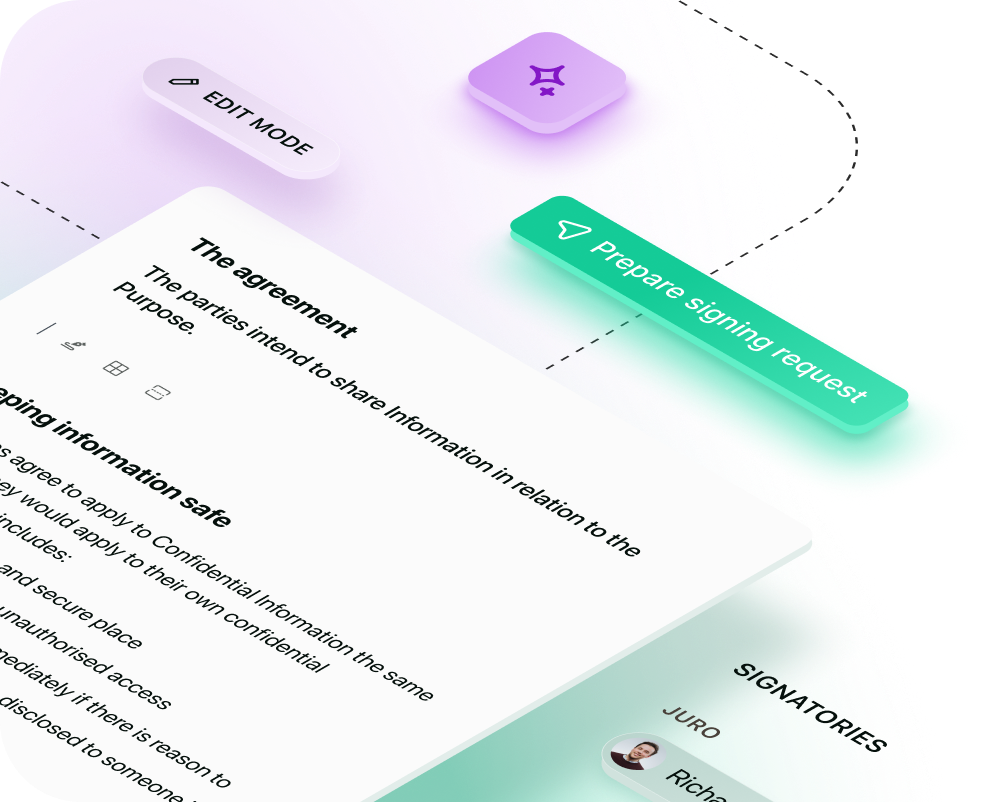Solutions
Customer Support
Resources
Use this SaaS agreement template to clarify expectations and deliverables for both providers and customers.




Managing contracts effectively is crucial for businesses – especially for those providing or using software as a service (SaaS). Fortunately, a well-structured SaaS agreement template can streamline this process, ensuring clarity and compliance while saving time and reducing legal risks. This article covers the essentials of SaaS agreements, their purpose, management, and how Juro can automate and enhance the SaaS contract management process.
A software as a service (SaaS) agreement is a contract between a SaaS provider and a customer that outlines the terms of the software’s use.
This agreement defines the relationship between the provider and the customer, specifying rights, responsibilities and obligations for both parties. It ensures that both the SaaS provider and the customer are on the same page when it comes to how the software can be used, the level of support provided and the expectations for service quality.
The primary purpose of a SaaS agreement is to establish clear guidelines and expectations. It helps to:
Managing SaaS agreements typically involves several key roles within an organization, depending on the end-users and the cost of the platform.
Legal professionals are responsible for drafting, reviewing and negotiating the terms of SaaS agreements. They ensure compliance with relevant laws and regulations, address risk management and protect the company’s interests.
The procurement team oversees the acquisition of SaaS services. They manage vendor relationships, evaluate service offerings and ensure that the agreements align with the company's procurement policies and budgets.
IT professionals evaluate the technical aspects of the SaaS solutions. They ensure compatibility with existing systems, assess security measures and manage implementation and integration.
Specialists in compliance and risk management make sure that the SaaS agreements meet regulatory requirements and company policies. They identify and mitigate risks associated with data privacy, security and compliance.
Finance teams manage the financial aspects of SaaS agreements, handling costs analysis, budgeting and financial reporting related to the services.
End-user departments – such as marketing, sales or HR – may initiate the need for SaaS solutions. They work with the above teams to define requirements, assess usability and ensure the solution meets their operational needs.
Dedicated vendor managers or contract managers may be responsible for ongoing relationship management with SaaS providers, monitoring performance and managing renewals or terminations.
Effective SaaS agreement management requires collaboration between these different roles to maximize the benefits of the SaaS solutions while minimizing potential risks and costs.

SaaS agreements are used whenever a company provides or subscribes to software services delivered over the internet. This includes:
A comprehensive SaaS agreement template should cover the following elements:
Parties involved. Clearly identify the provider and the customer.
Definitions. Define key terms used in the agreement to avoid ambiguity.
Scope of services. Detail the software services provided, including specific features and functionalities.
User rights and restrictions. Specify who can use the software and any usage limitations – such as the number of users or devices.
Pricing and payment terms. Outline costs, billing cycles, payment methods and penalties for late payments.
Service levels and support. Define performance metrics, uptime guarantees and terms for customer support, including response times and support channels.
Data protection and privacy. Include clauses on data security, privacy policies, compliance with regulations like GDPR, and the handling of personal data.
Intellectual property rights. Clarify ownership of the software and any related intellectual property, including customer data and any customizations or integrations.
Confidentiality. Ensure both parties agree to protect confidential information, detailing what constitutes confidential information and the obligations to protect it.
Termination clauses. Detail conditions under which the agreement can be terminated, including breaches of contract, and the consequences of termination, such as data retrieval or continued access to certain services.
Dispute resolution. Provide mechanisms for resolving conflicts – such as mediation or arbitration – and specify the jurisdiction and governing law for the agreement.

Managing SaaS contracts manually involves several steps that require attention to detail, collaboration, and effective communication among various stakeholders. Here’s an overview of the typical manual process:
Managing SaaS contracts manually is labour-intensive and prone to errors, especially with high volumes of contracts. It requires meticulous coordination and communication among various teams to ensure that all aspects of the contract lifecycle are properly handled.
Juro can significantly streamline and improve the management of SaaS contracts through its AI-native contract management platform. Here’s how Juro can help:
.avif)
.avif)

By leveraging Juro’s AI-native contract management platform, organizations can streamline their SaaS contract management processes, reduce manual errors, ensure compliance and enhance overall efficiency. This allows teams to focus on strategic activities rather than getting bogged down by administrative tasks.
Juro's AI-native contract automation platform empowers all teams to create, agree, execute and manage contracts up to 10x faster than traditional tools. To find out more, hit the button below to book your personalized demo.
Juro is the #1-rated contract platform globally for speed of implementation.


Juro embeds contracting in the tools business teams use every day, so they can agree and manage contracts end-to-end - while legal stays in control.
Book your demo